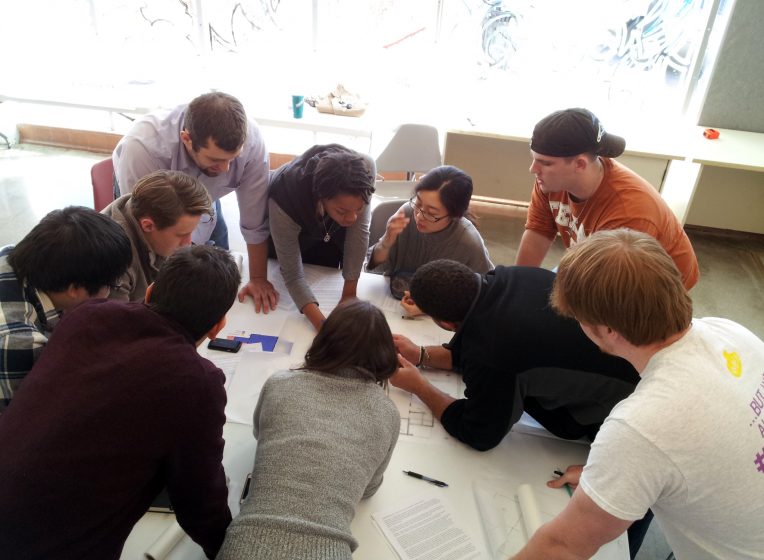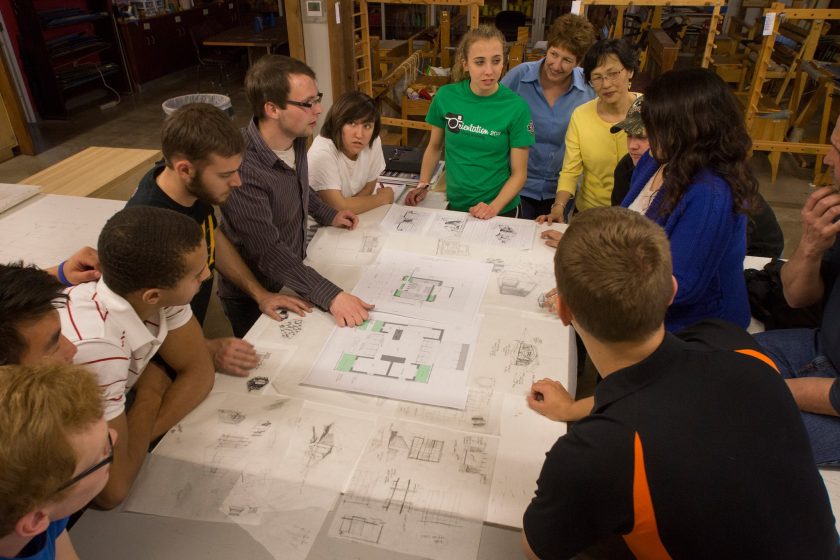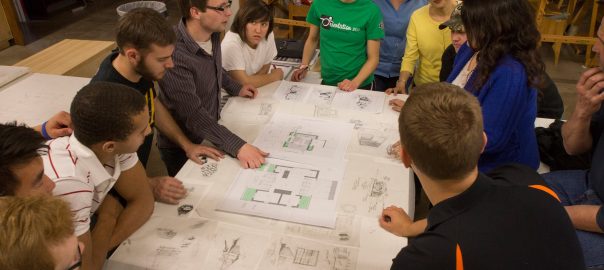Inspiring students to contribute in an impactful manner to their community and society while developing the professional skills needed for their major (architecture) has been my passion for the past nineteen years. The goal all those years ago was to create and execute unique educational challenges, expand the field of architecture and bring hope, healing, and inspiration to the communities we would serve.
The method by which this was explored is Design-Build. In this context, Design-Build is a program in the Hammons School of Architecture at Drury University that challenges students to design and build architecture projects for charities or communities in need.
As Drury Design-Build developed through the years, many lessons were learned, best practices developed, but a significant discovery was made. The inclusion of non-architecture students in the design-build process challenges both architecture and non-architecture students in new ways and enriches the educational and physical outcomes.
A small number of design-build programs exist at universities across the country, all of impressive quality. Each is set in a school of architecture and is open exclusively to architecture students. The whole-school model of the Drury Design-Build program differs in that it opens participation on projects to the entire student body at the institution and encourages students in all majors of the university to participate in all phases of design, construction, and all other aspects of the project.
The theory is that students from varied majors will bring diverse approaches to critical thinking and problem-solving using the perspective of their disciplines in the design and implementation process. Students in liberal arts and professional programs, including fine arts, philosophy, physics, biology, music, communications, business administration, and marketing are commonly involved in our projects. Everyone is encouraged to participate in design discussions and have input and impact on design. The whole-school method benefits students from all disciplines as they take lessons learned from the experiences and apply them to their course work in their respective majors.[i]
The whole-school approach challenges both architecture and non-architecture students through a dialogue that starts with conceptual design and moves forward through completion of the project. The variety of disciplines represented by the participating students result in innovative collaborations as team members learn to solve problems from various approaches and paradigms. The lively dialogue enriches the design and creates life-long connections and friendships.

Welcoming non-architecture students to the team at the beginning of the design process creates a rare opportunity for this group to appreciate and challenge concepts of architecture. Many from this group will go on to apply this experience throughout their lives as they become clients of architects, decisionmakers, and more architecture-aware occupants of the built environment.
Pairing the whole-school, design-build approach with serving communities in need is a unique and effective way to serve communities through the profession of architecture. All fifteen of the Drury Design-Build projects to date respond to a societal need whether it is physical (built), spiritual (uplifting), or personal (healing), but perhaps the most effective in challenging, educating, and inspiring our students have been the whole-school projects in which the liberal arts and professional students collaborated.
The outcome for the communities served by these transdisciplinary groups tends to be projects with broader and deeper conceptual aspirations and more in tune with the variety of outlooks and perspectives that a client (community group) might have.
During the design process, diverse perspectives and approaches to a project are taken seriously, respected and often celebrated during the design-build process. The collaborations often create bonds between students that carry long past graduation.
The recently published book, Exploring, Experiencing, and Envisioning Integration in US Arts Education (The Arts in Higher Education), edited by Nancy Hensel, explores the dedication of the New American Colleges & Universities to the purposeful integration of liberal education, professional studies, and civic engagement through the performing, literary, and visual arts. The authors believe that the development of professional skills in combination with the theoretical aspects of liberal arts curriculum, which traditionally including music, theatre, art and literature, provides a high quality undergraduate educational experience that uniquely prepares students for adaptability in their careers and engaged citizenship grounded in the ability to think creatively, critically, and ethically.[ii]

The whole-school, design-build approach is a mashup of Hensel and the author’s arguments that developing professional skills through a liberal arts education prepares students for adaptability in their careers and creates a more engaged citizen. The educational approach here is to actively combine and create collaboration between liberal arts students and professional students on a single project.
Today’s architect is expected to understand the perspectives and needs of a broad, never-ending range of clients. The problem is that architecture students have minimal opportunities to be challenged by external points of view while in school. Collaboration on an architecture project with a history, literature, theatre, or environmental biology major will further expand the education and perspectives of architecture students. The whole-school approach challenges students to think through the visions and perspectives of others. Partnering with other professional schools and liberal arts disciplines across campus allows this important interaction.[iii]
A student in a professional school such as management and a theatre student in the liberal arts will be trained to think critically and creatively in very different ways; their perspectives differ yet again from those of an architecture student. In their professional careers, non-architecture students may later become the clients of architects, collaborating at some level with an architect on the design of a building. In our academic setting, the business, theatre, and architecture students are all equally responsible for the design-build outcomes.[iv]
This whole-school method also gives liberal arts and other students not majoring in architecture an opportunity to put their ideas, knowledge, and skill sets to the test in a very different way than the typical engaged-learning experience provides, enriching students’ preparation for their particular careers and delivers a richer project to the community.[v]
The influence and effects on design of such diverse groups of students can be rich and rigorous. Working with transdisciplinary teams has steadily increased the rigor of our work and improved design outcomes. New friendships have formed and long-term professional connections have begun for students. This inclusive strategy of cross-pollination of liberal arts and professional students has had overwhelmingly rewarding results for students, professors, stakeholders, and recipients of the projects.[vi]
The experience of designing and building these projects has educated and hopefully inspired hundreds of students in and outside the profession of architecture, aided communities in great need, and instilled hope and healing in many who have participated in and been recipients of the work.
Traci Sooter
Springfield
Notes:
[i] Exploring, Experiencing, and Envisioning Integration in US Arts Education (The Arts in Higher Education), Nancy Hensel editor, Palgrave Macmillan; 1st ed. 2018 edition (February 12, 2018), Chapter 3, Architecture and the Liberal Arts: A Whole-School Approach to Community Engagement, Traci Sooter ISBN-10: 3319710508; ISBN-13: 978-3319710501
[ii] Exploring, Experiencing, and Envisioning Integration in US Arts Education (The Arts in Higher Education), Nancy Hensel editor, Palgrave Macmillan; 1st ed. 2018 edition (February 12, 2018), ISBN-10: 3319710508; ISBN-13: 978-3319710501
[iii] Exploring, Experiencing, and Envisioning Integration in US Arts Education (The Arts in Higher Education), Nancy Hensel editor, Palgrave Macmillan; 1st ed. 2018 edition (February 12, 2018), Chapter 3, Architecture and the Liberal Arts: A Whole-School Approach to Community Engagement, Traci Sooter ISBN-10: 3319710508; ISBN-13: 978-3319710501
[iv] Exploring, Experiencing, and Envisioning Integration in US Arts Education (The Arts in Higher Education), Nancy Hensel editor, Palgrave Macmillan; 1st ed. 2018 edition (February 12, 2018), Chapter 3, Architecture and the Liberal Arts: A Whole-School Approach to Community Engagement, Traci Sooter ISBN-10: 3319710508; ISBN-13: 978-3319710501
[v] Exploring, Experiencing, and Envisioning Integration in US Arts Education (The Arts in Higher Education), Nancy Hensel editor, Palgrave Macmillan; 1st ed. 2018 edition (February 12, 2018), Chapter 3, Architecture and the Liberal Arts: A Whole-School Approach to Community Engagement, Traci Sooter ISBN-10: 3319710508; ISBN-13: 978-3319710501
[vi] Exploring, Experiencing, and Envisioning Integration in US Arts Education (The Arts in Higher Education), Nancy Hensel editor, Palgrave Macmillan; 1st ed. 2018 edition (February 12, 2018), Chapter 3, Architecture and the Liberal Arts: A Whole-School Approach to Community Engagement, Traci Sooter ISBN-10: 3319710508; ISBN-13: 978-3319710501












Add a Comment
Join our conversation